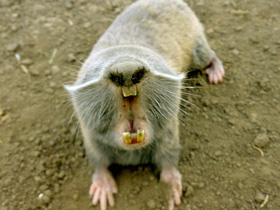The giant blind mole-rat (Spalax giganteus)
 The giant blind mole-rat (Spalax giganteus) is listed in the Red Data Book of Russia
The giant blind mole-rat (Spalax giganteus) is listed in the Red Data Book of Russia
The giant blind mole-rat (Spalax giganteus) is a species of rodent in the family Spalacidae endemic to the North Caucasus region of Russia. It feeds on roots and tubers and lives underground in a burrow that it digs with its teeth.
External species
Spalax giganteus is a mammal of the blind family of the rodent family. It is the largest representative of the gadfly subfamily: its body length is 25-35 cm and its weight reaches 1 kg. The upper body colouration is light, grey-pale or ochre-brown. In old animals the top of the head is practically white. Dark grey tones prevail in the colouration of the fur on the belly. Some specimens have white spots on the belly and forehead (partial albinism). There is no geographic variability in size and colouration.
Habitat
Spalax giganteus is an endemic of semi-deserts of the Caspian coastal areas of the north-eastern Pre-Caucasus. It inhabits the lower reaches of the Kuma, Terek and Sulak rivers. In the north it slightly goes beyond the Kuma River, and in the south it penetrates to the Gudermes-Makhachkala line. In Dagestan it inhabits the Tersko-Kuma and Tersko-Sulak lowlands. A small isolated area of habitat in the extreme south of Kalmykia has apparently disappeared. Blind Grouse are isolated beyond the lower reaches of the Ural River along the floodplains of the Tersko-Kum and Tersko-Sulak rivers. Ural along the floodplains of the rivers Wil, Temir and Emba (Kazakhstan) are sometimes recognised as a separate species, the Ural gadfly (Spalax uralensis). Within its small range the species is distributed very unevenly and mosaically: as separate settlements, often confined to massifs of sands.
Spalax giganteus, unlike other species of gadflies, inhabits clay and sandy semi-deserts, however, adhering to relatively moist areas with light soils in river valleys, lake hollows and depressions of relief. It is also found in cereal-grass and wormwood-grass steppes. Does not go deep into unfastened sands. May use favourable anthropogenic habitats: gardens, fields of alfalfa and other forage grasses, homestead plots. In Kazakhstan, in addition, it settles in forest edges and forest glades.
Lifestyle, nutrition and reproduction
Leads a strictly underground, sedentary way of life, building multilevel systems of passages. Digs the ground mainly with incisors. Underground feeding passages (11-16 cm in diameter) are laid at a depth of 20-50 cm, often in layers of sand. On the ground surface they are marked by soil outbursts in the form of truncated cones 30-50 cm high. The total length of feeding tunnels reaches several hundred metres. Nesting chambers and larders are located at a depth of 0.9 to 3 metres.
The behaviour of Spalax giganteus is practically unstudied. It is active all the year round; it does not hibernate. Swarming activity peaks in spring (March-April). It feeds mainly on underground parts of plants (rhizomes, bulbs, tubers). Makes stocks of fodder, reaching 2-2.5 kg.
Mating period occurs in December-January; brood averages 2-3 cubs. Females probably bear offspring not more often than once every 2 years. The cubs remain with the mother even after the end of lactation, but by autumn all young are dispersed. Sexual maturity occurs in the 2nd year of life. Spalax giganteus has practically no natural enemies and competitors due to its secretive way of life. Settling young are sometimes hunted by foxes, cats and birds of prey.
Conservation status
Rare, narrow-areal and poorly studied species with low reproductive potential. Numbers are stable or declining. Further fragmentation of the range and reduction of individual populations due to anthropogenic pressure: ploughing of large areas of land, construction of irrigation canals, overgrazing. Spalax giganteus is subject to protection as a species listed in the Red Data Book of Russia and the IUCN Red List.
















































